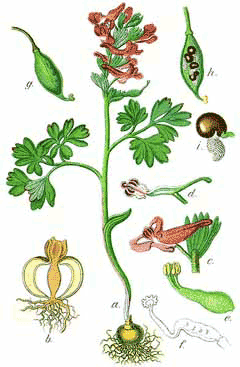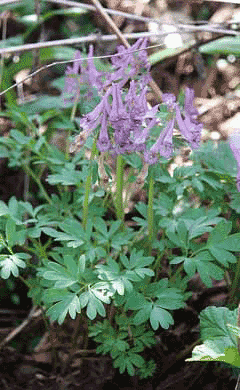 |
|
http://commons.wikimedia.org/wiki/File:Corydalis_solida_Sturm44.jpg |
 |
| http://commons.wikimedia.org/wiki/User:BerndHCorydalis ternata |
Translate this page:
Summary
Physical Characteristics

 Corydalis solida is a PERENNIAL growing to 0.2 m (0ft 8in) by 0.1 m (0ft 4in).
Corydalis solida is a PERENNIAL growing to 0.2 m (0ft 8in) by 0.1 m (0ft 4in).
See above for USDA hardiness. It is hardy to UK zone 6 and is not frost tender. It is in leaf from March to July, in flower from April to May, and the seeds ripen from May to June. The species is hermaphrodite (has both male and female organs) and is pollinated by Bees. The plant is self-fertile.
Suitable for: light (sandy) and medium (loamy) soils and prefers well-drained soil. Suitable pH: mildly acid, neutral and basic (mildly alkaline) soils. It can grow in semi-shade (light woodland). It prefers moist soil.
UK Hardiness Map
US Hardiness Map
Synonyms
C. bulbosa. C. halleri.
Plant Habitats
Woodland Garden Dappled Shade; Shady Edge;
Edible Uses
Edible Parts: Root
Edible Uses:
Root - boiled[46, 61, 105, 115]. Rich in starch[2]. Some caution is advised, there is a report that the plant is toxic.
References More on Edible Uses
Medicinal Uses
Plants For A Future can not take any responsibility for any adverse effects from the use of plants. Always seek advice from a professional before using a plant medicinally.
Anodyne Antibacterial Antispasmodic Hallucinogenic Nervine Sedative
Fumewort has been used as a painkiller in Chinese medicine for over 1,000 years[238]. The tuber is anodyne, antibacterial, antispasmodic, hallucinogenic, nervine and sedative[9, 13, 238]. It is used internally as a sedative for insomnia and as a stimulant and painkiller, especially in painful menstruation, traumatic injury and lumbago[238]. It is also used for lowering the blood pressure[9, 13]. Research suggests that it also has an action in the thyroid and adrenal cortex[238]. The tuber should not be prescribed for pregnant women[238]. The tubers are harvested when the plant is dormant and are dried for later use[238].
References More on Medicinal Uses
The Bookshop: Edible Plant Books
Our Latest books on Perennial Plants For Food Forests and Permaculture Gardens in paperback or digital formats.

Edible Tropical Plants
Food Forest Plants for Hotter Conditions: 250+ Plants For Tropical Food Forests & Permaculture Gardens.
More

Edible Temperate Plants
Plants for Your Food Forest: 500 Plants for Temperate Food Forests & Permaculture Gardens.
More

More Books
PFAF have eight books available in paperback and digital formats. Browse the shop for more information.
Shop Now
Other Uses
References More on Other Uses
Cultivation details
Prefers a moist, well-drained rather light soil, thriving in semi-shade. Grows well in a woodland garden or peat bed. Increases well when grown in a bulb frame, but less freely when grown in the garden[90]. A very ornamental[1] and easily grown plant[129]. There are some named varieties[90]. Plants seem to be immune to the predations of rabbits[233].
References Carbon Farming Information and Carbon Sequestration Information
Temperature Converter
Type a value in the Celsius field to convert the value to Fahrenheit:
Fahrenheit:
The PFAF Bookshop
Plants For A Future have a number of books available in paperback and digital form. Book titles include Edible Plants, Edible Perennials, Edible Trees,Edible Shrubs, Woodland Gardening, and Temperate Food Forest Plants. Our new book is Food Forest Plants For Hotter Conditions (Tropical and Sub-Tropical).
Shop Now
Plant Propagation
Seed - best sown as soon as it is ripe, the seed rapidly loses viability if it is allowed to become dry[129]. Surface sow and keep moist, it usually germinates in 1 - 3 months at 15°c[164]. Germinates in spring according to another report[129]. Two months warm, then a cold stratification improves the germination of stored seed[134, 164]. Sow the seed thinly so that the seedlings can be allowed to grow undisturbed in the pot for their first year. Apply liquid feed at intervals during their growing season to ensure they are well fed. The seedlings only produce one leaf in their first year of growth[175] and are very prone to damping off[129]. Divide the seedlings into individual pots once they have become dormant and grow them on in a partially shaded area of a greenhouse for at least another year. Plant them out into their permanent positions when they are dormant. Division after flowering.
Other Names
If available other names are mentioned here
Native Range
TEMPERATE ASIA: Turkey, Russian Federation (Krasnoyarsk, Tyva, Respublika) EUROPE: Finland (south), Austria, Belgium, Czech Republic, Germany, Hungary, Netherlands, Poland, Slovakia, Russian Federation (European part), Belarus, Estonia, Lithuania, Latvia, Moldova, Ukraine, Albania, Bulgaria, Bosnia and Herzegovina, Greece, Croatia, Italy (incl. Sicily), North Macedonia, Montenegro, Romania, Serbia, Slovenia, Spain (northeast), France (incl. Corsica) AFRICA: Algeria (north)
Weed Potential
Right plant wrong place. We are currently updating this section.
Please note that a plant may be invasive in one area but may not in your area so it's worth checking.
Conservation Status
IUCN Red List of Threatened Plants Status :

Growth: S = slow M = medium F = fast. Soil: L = light (sandy) M = medium H = heavy (clay). pH: A = acid N = neutral B = basic (alkaline). Shade: F = full shade S = semi-shade N = no shade. Moisture: D = dry M = Moist We = wet Wa = water.
Now available:
Food Forest Plants for Mediterranean Conditions
350+ Perennial Plants For Mediterranean and Drier Food Forests and Permaculture Gardens.
[Paperback and eBook]
This is the third in Plants For A Future's series of plant guides for food forests tailored to
specific climate zones. Following volumes on temperate and tropical ecosystems, this book focuses
on species suited to Mediterranean conditions—regions with hot, dry summers and cool, wet winters,
often facing the added challenge of climate change.
Read More
Expert comment
Author
(L.)Clairv.
Botanical References
200
Links / References
For a list of references used on this page please go here
Readers comment
| Add a comment |
|
If you have important information about this plant that may help other users please add a comment or link below. Only comments or links that are felt to be directly relevant to a plant will be included. If you think a comment/link or information contained on this page is inaccurate or misleading we would welcome your feedback at [email protected]. If you have questions about a plant please use the Forum on this website as we do not have the resources to answer questions ourselves.
* Please note: the comments by website users are not necessarily those held by PFAF and may give misleading or inaccurate information.
To leave a comment please Register or login here All comments need to be approved so will not appear immediately.
|
Subject : Corydalis solida
|
|
|
|